This will be our little secret
Before I tell you about Ljubljana, let me start with an old joke about a father who is very protective of his daughter:
A younger man and an older man were sitting next to each other at a bar. The younger man said, “Mister, could you tell me what time it is?”
The older man replied, “No.”
Young man: “But I see you have a watch. Why won’t you tell me the time?”
The older man turned to him and said, “Look, it’s like this. If I tell you the time, we’ll probably start talking about the weather. Then we’ll talk about our families and I’ll probably show you a photo of my daughter. You’ll think she’s beautiful and want to meet her. You’ll probably fall in love and want to marry her. And I don’t want my daughter married to any guy who’s too cheap to buy a watch!”
I have a similar feeling about describing Ljubljana. It’s like this: It’s a beautiful city, full of friendly people. The streets are clean. The food is wonderful. There are lots of dragons. And it’s not overrun with tourists.
But if I tell you about it, you’re going to want to go there. And when you do, you’ll tell all your friends. And they’ll tell their friends. And the travel bloggers will write about it and everyone will want to go there. And pretty soon, it’ll be like every other major European city – overrun with selfie-snapping tourists and Aperol spritz bars. It’ll be ruined.
So look, I’m going to tell you about Ljubljana. But it’s going to be our secret, OK? Don’t tell anyone!
Where is Ljubljana, anyway?
Ljubljana (“lyoo-BLYAH-nuh”) is the capital of Slovenia. Three years ago, we couldn’t have found Slovenia on a map. But we’ve learned a lot about European geography while living in Portugal.
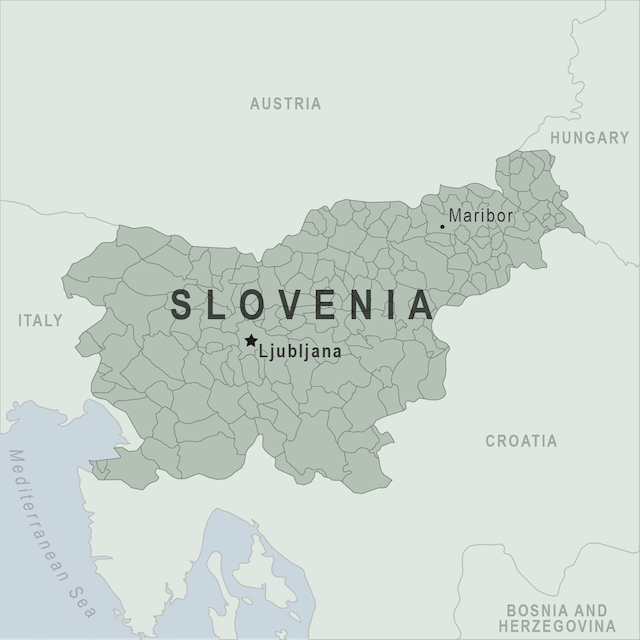
Slovenia is a country of about 2 million people on the Adriatic peninsula. It is east of Italy, west of Hungary, south of Austria, and north of Croatia. It was formerly part of Yugoslavia, but declared its independence in 1991. Slovenia joined the European Union and NATO in 2004.
A bit of local history
People have been living in the area now known as Ljubljana for over 4,000 years. Around the 1st century BC, the Romans established a fortified city there. They called it Emona, a name that is still seen sometimes today.
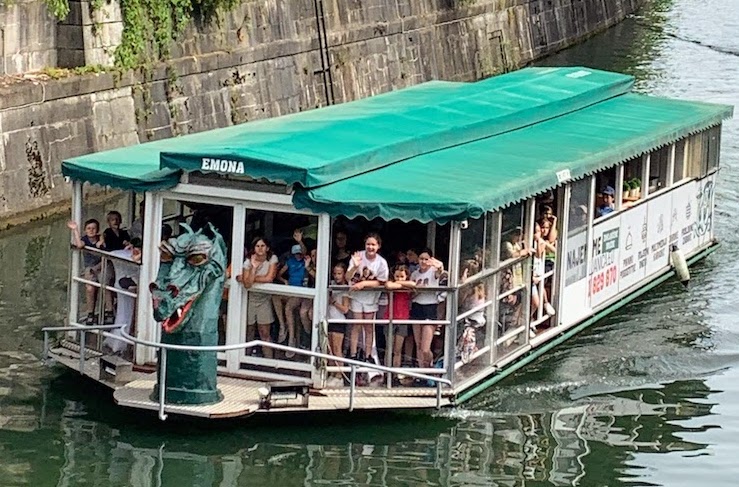
Ljubljana has an interesting origin story.
Legend has it that Ljubljana was founded by the Greek mythological hero Jason and his companions, the Argonauts, who had stolen the golden fleece from King Aetes and fled from him across the Black Sea and up the Danube, Sava and Ljubljanica rivers.
They stopped at a large lake in the marsh near the source of the Ljubljanica, where they disassembled their ship to be able to carry it to the Adriatic Sea, put it together again, and return to Greece. The lake where they made a stop was the dwelling place of a monster. Jason fought the monster, defeated it and killed it. The monster, now referred to as the Ljubljana Dragon, found its place atop the castle tower on the Ljubljana coat of arms.
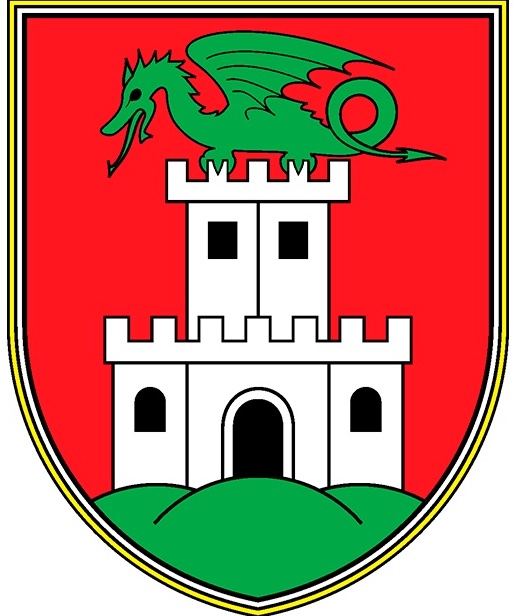
Ljubljana today
Modern day Ljubljana is a city of nearly 300,000, one of the smaller European capitals. The Ljubljanica River winds through the center of the city and separates the old city from the newer, more commercial sections. In the area we were staying, near the Prešernov trg (Prešeren Square, the central square of Ljubljana) the river was lined with cafés. The look is very old-world Europe and the atmosphere is tranquil and unhurried.
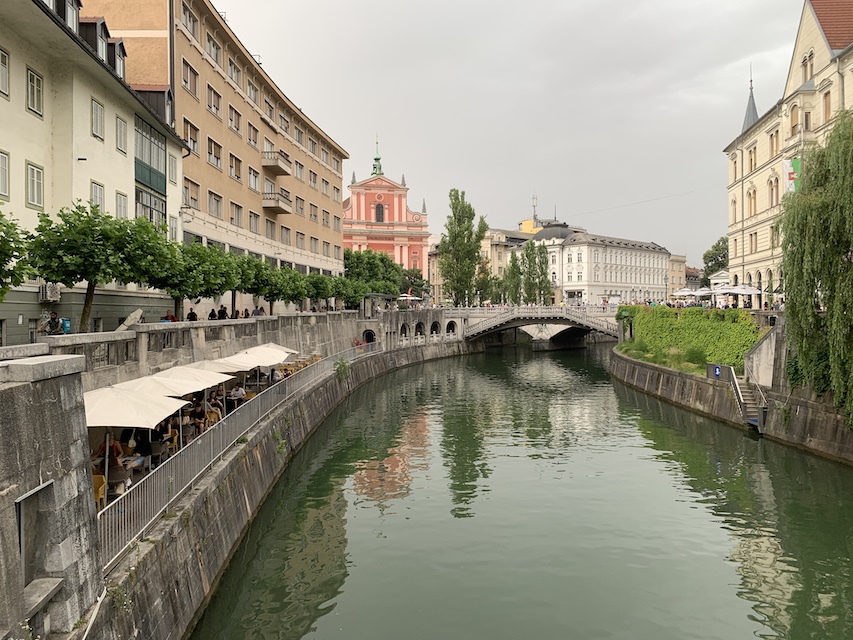
There are several bridges that cross the river. One of them, Zmajski most (the Dragon Bridge), has a bronze dragon at each corner. With their tails wrapping around the pedestals, they look as if they are ready to fly. Traffic flow on the bridge was orderly, so perhaps the dragons exert a calming influence on rush hour drivers.
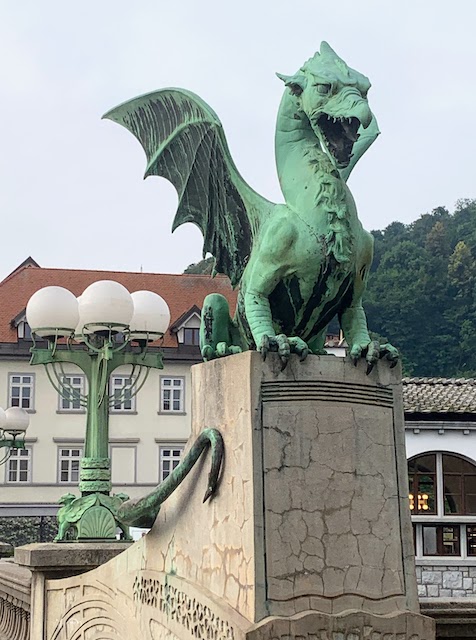
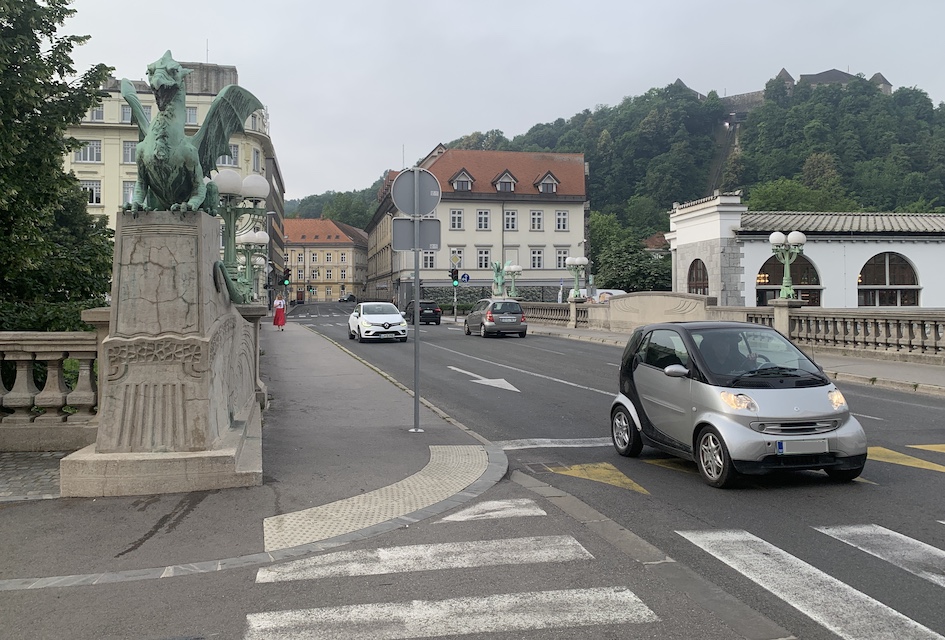
One of the most iconic sights in Ljubljana is the Tromostovje, or Triple Bridge. It connects Prešeren Square to the old city. There have been several bridges at this location since the 13th century. In 1842, a new bridge was built on the site and dedicated to Archduke Franz Karl. Over time, Franz’s bridge became a bottleneck and in 1829, the Slovenian architect Jože Plečnik designed an extension – two footbridges set on either side at a slight angle.
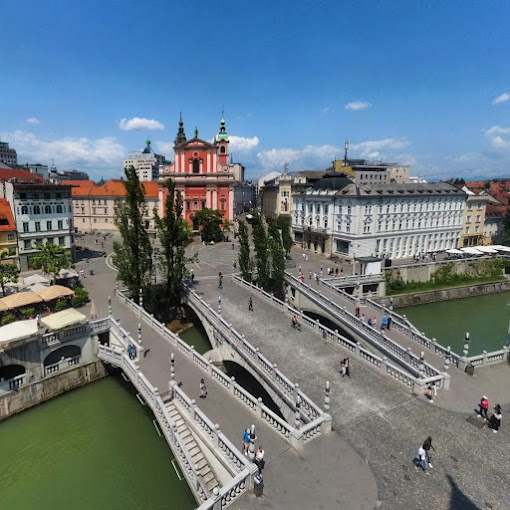
Where once it carried vehicular traffic, the area around the bridge is now a pedestrian-only area. In 2021, the Triple Bridge was named a the UNESCO World Heritage Site.
A concert in the park
When we arrived in Ljubljana, we saw signs that something special was happening. On our way to our hotel, we walked through a large plaza where a stage had been erected and hundreds of folding chairs were being set out in neat rows. We learned shortly after that it was the opening day of the 72nd annual Ljubljana Festival.
The concert didn’t start until 8:45pm, so we had time to wander around the old part of the city and get some dinner. The area with folding chairs was fenced off, reserved for people who had purchased tickets to the concert.
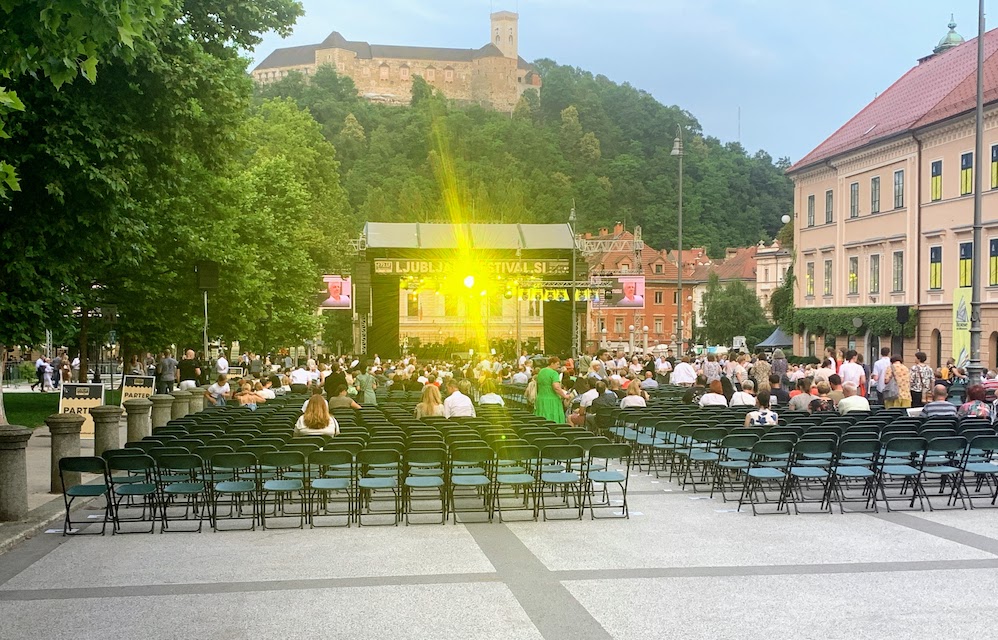
That’s Ljubljana Castle at the top of the hill.
But immediately adjacent was a large public park – Park Zvezda (Star Park) – where people were gathering with friends and families to picnic, enjoy a pleasant summer evening, and watch the concert on large video screens.
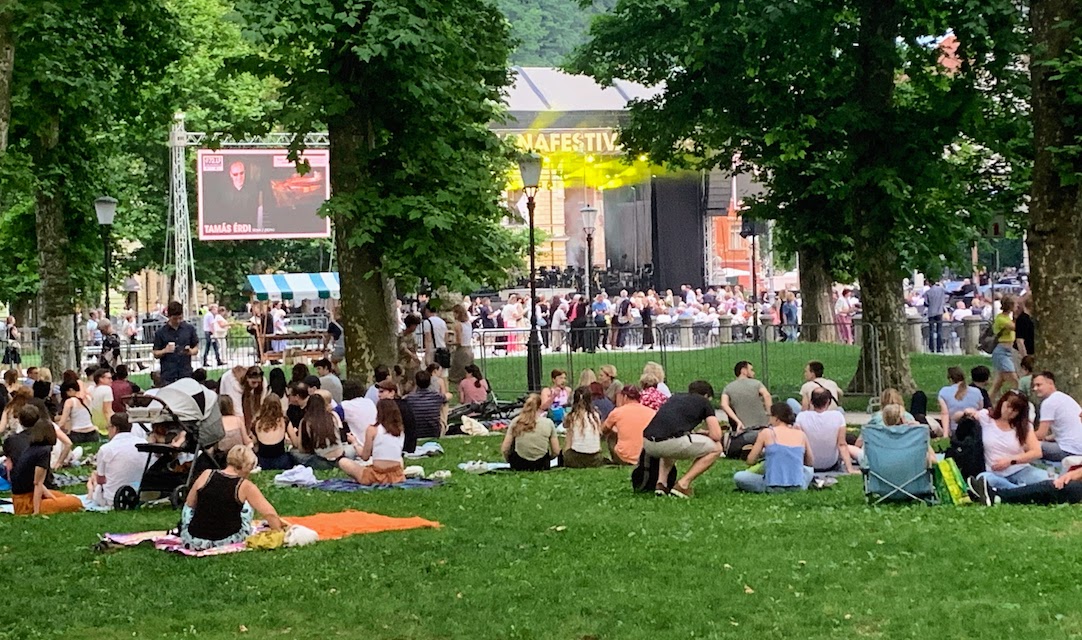
While waiting for the concert to begin, we saw a well-dressed couple approaching the plaza on bicycles. I was just in the right spot to take a photo of the woman, wearing a beautiful white dress, riding her bike.
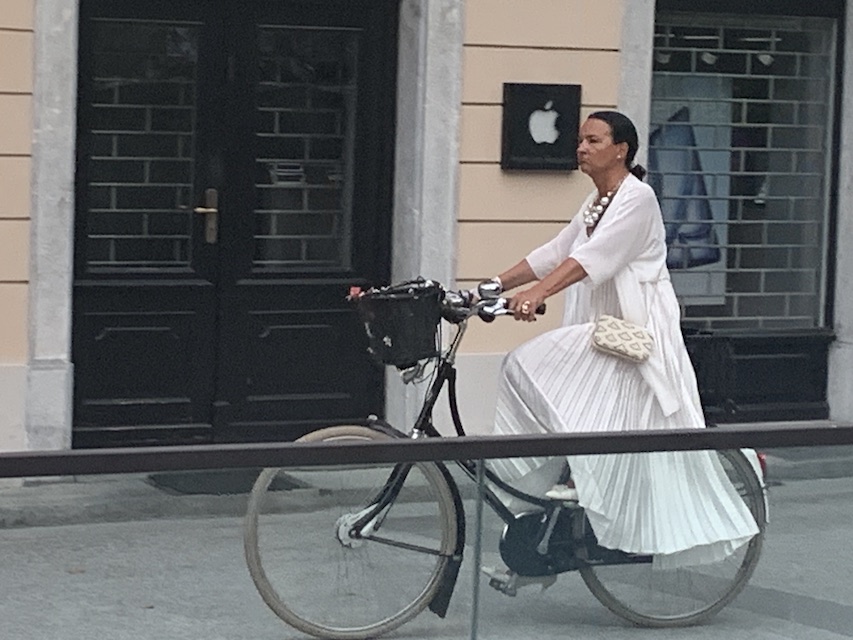
When they parked their bikes, we approached and introduced ourselves. She was Andreja, he was Tibor. We showed them the picture and talked with them about the concert. They said they attended every year. (I sent them a copy of the photo later in the evening.)
The concert was what we would call a “Pops” concert in the US. The program was a selection of songs by three well-known Slovenian songwriters – Ditka Haberl, Alenka Pinterič, and Neca Falks. The music was provided by the RTV Slovenia Symphony Orchestra and Big Band. An emcee introduced each song and the soloist who would perform it.
We didn’t know the words being spoken or the lyrics of the songs, but it didn’t matter – we understood enough: It was a beautiful summer evening and we were standing in the middle of a park, under a full moon, listening to the songs, surrounded by people who were singing along.
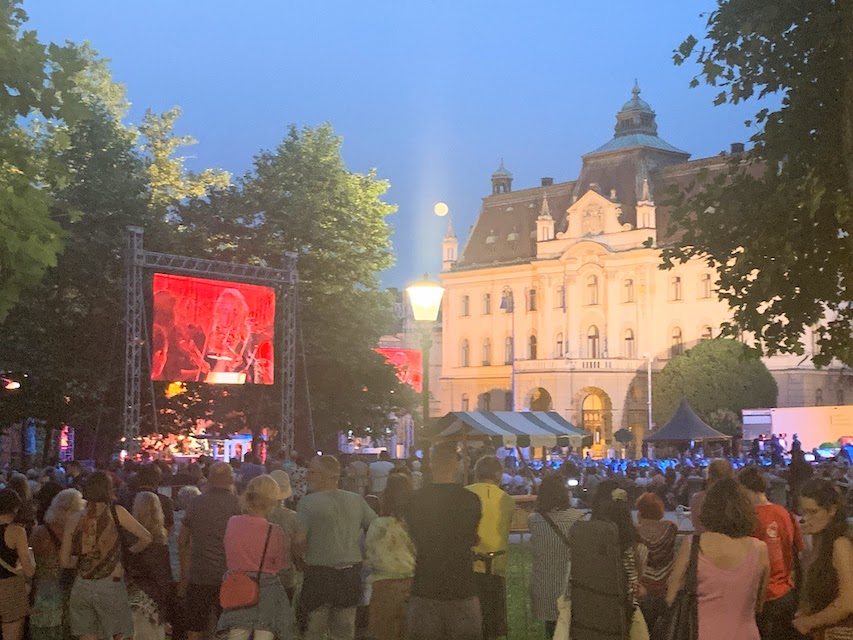
Then there was the food!
The next day was dedicated to (surprise!) – food.
We started the day with pastries and coffee at a small café across the street from a large open-air market. After breakfast we wandered through the market. The fruits and vegetables on display looked delicious.
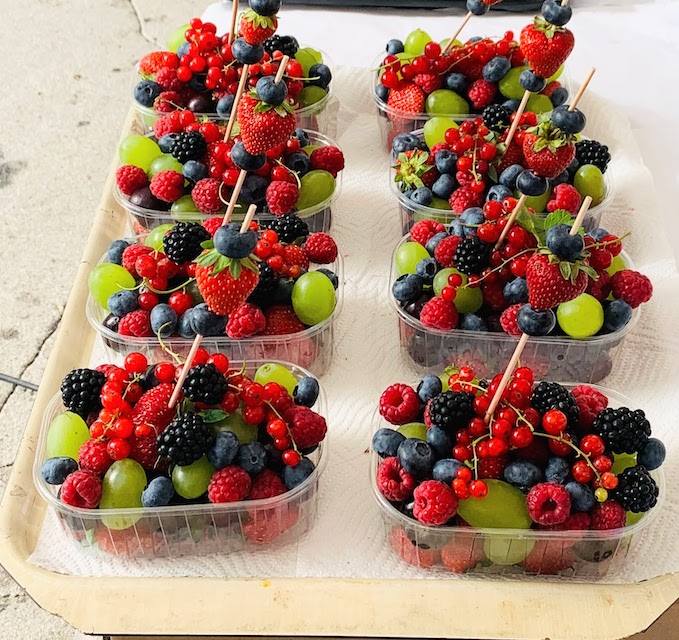
The old part of the city was quiet and almost deserted in the early morning. Other than the occasional cyclist or jogger, we felt like we had the town to ourselves.
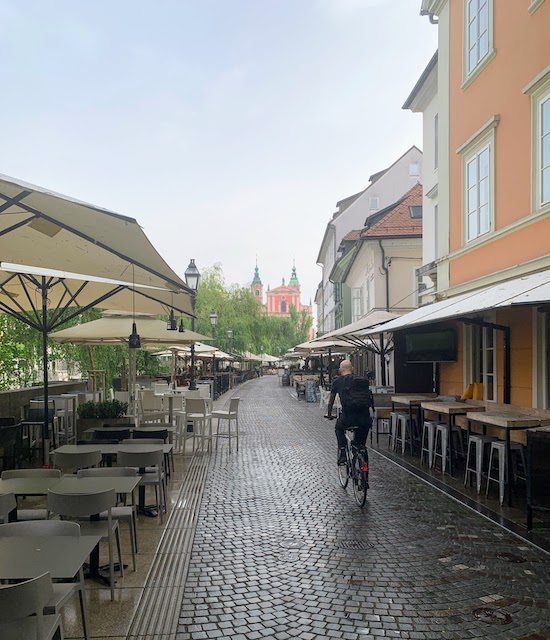
Throughout the day we wandered the streets of the old city, but we kept returning to one block – the location of the Odprta Kuhna – the Open Kitchen. We had read about it before coming to Ljubljana and wanted to experience as much as we could.
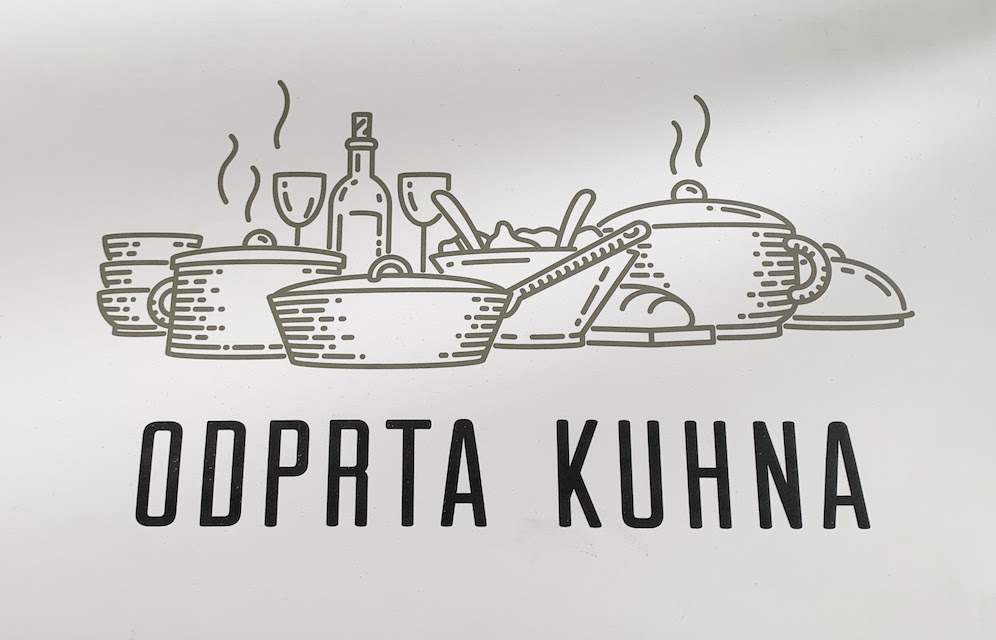
The Open Kitchen is an open-air food market that has operated in Ljubljana for 12 years. Several dozen different local and regional restaurants set up stands every week.
When it was time for lunch, we walked through all the stands and looked at the different foods being offered. Mary was in the mood for ribs, so that’s what we got. The crew from the Stari Pisker Steakhouse had a pit setup that would have made any Memphis In May BBQ contestant proud.
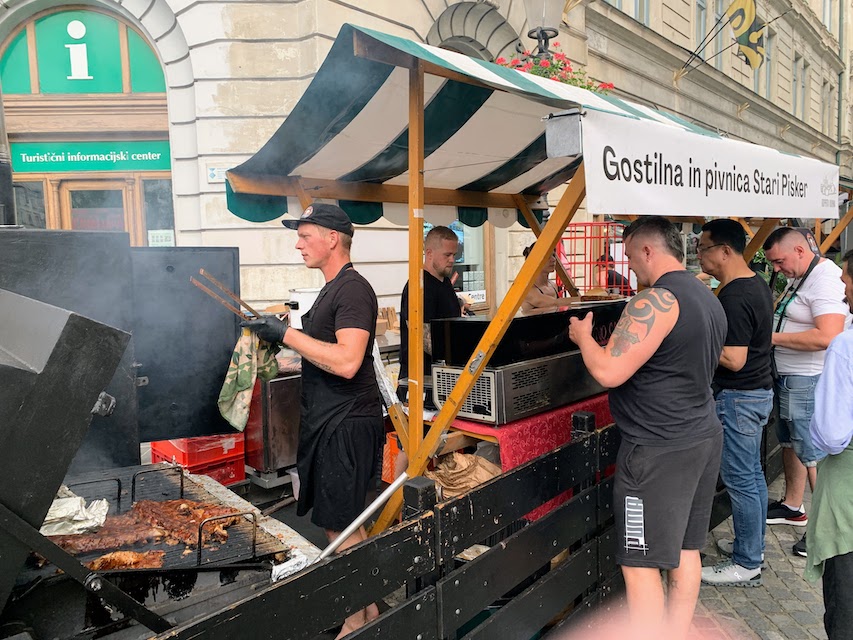
We split a full order and ate at an outdoor table. Lunch, including two beers, was € 21.50. They were the best ribs (ok, the only ribs, but still…) we’ve had in Europe.
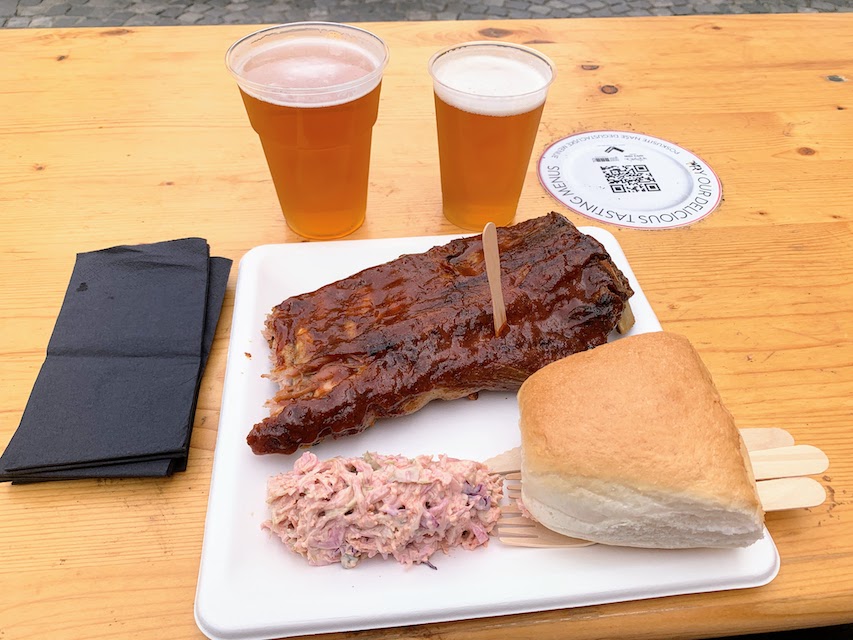
For dinner that same day, we had signed up for the “Gourmet Ljubljana Tasting Menu”. It guaranteed us a seat at a “private table booked for gourmet adventurers”, and several courses of food and wine.
The private table was another picnic table outside, which was fine with us. Lior Kochavy, the owner of Open Kitchen, joined us shortly after our starter arrived. Originally from Tel Aviv, he has been in Slovenia for 15 years.
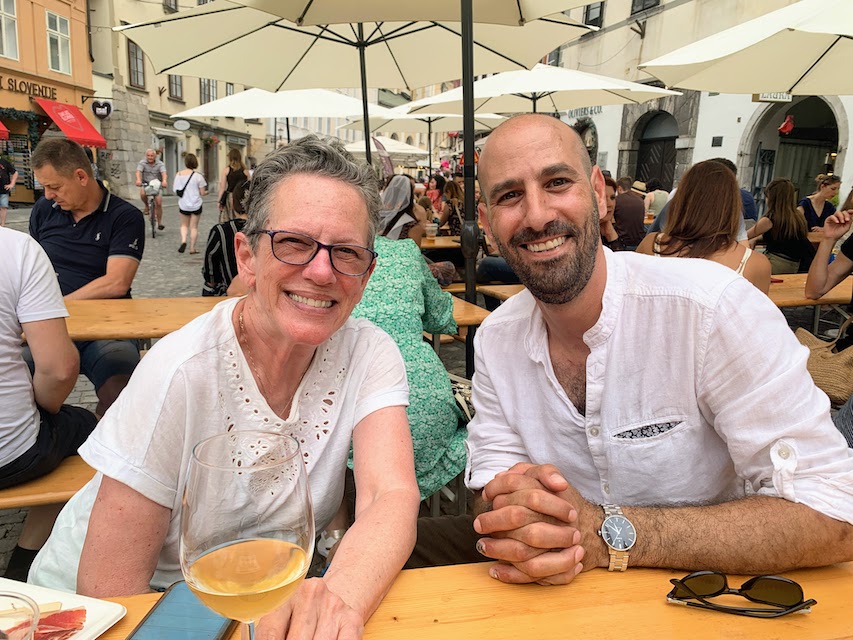
Lior gave us a detailed overview of how the Open Kitchen operates. He said they had a pool of 65 to 70 restaurants that participate, with about 45 there on any given week. They select restaurants to participate based on three criteria:
- Quality. They must be excellent and have established restaurants or businesses.
- Creativity.
- Innovation.
Lior said that they intentionally do not include any vendors of classic street food. They wanted to showcase Slovenian cuisine.
He was proud of the fact that they are able to recycle 95% of the single-use items used, like utensils, plates, and cups. Everything is biodegradable. Wine is only served in glasses.
The name Open Kitchen was deliberate, he said, meaning that they wanted the event to be accessible by everyone. They are currently serving 23,000 to 26,000 people every week.
Our meal was delightful. A member of the Open Kitchen team delivered each course and described the dish. Lior provided some extra commentary. Here are the dishes we enjoyed.
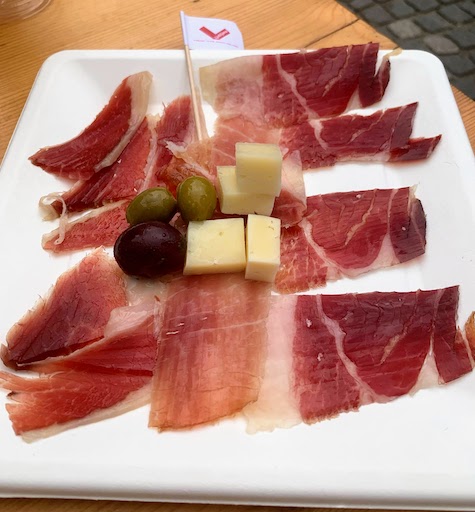
The starter was a plate with three types of prosciutto:
- Austro-Hungarian – rich flavor, salty finish
- Slovenian – lighter color, milder, salty throughout
- Spanish – salty, like a country ham
Another surprise: Mary liked the olives!
The warm appetizer was trofie pasta with black truffle shavings, from the Domačija Lisjak 1956 restaurant. It had a rich flavor like we’ve never tasted before.
Lior said that these truffles are picked in the winter and preserved for use later in the year. They get their flavor after the first frost. He said truffle hunters work all year, but the truffles found in the spring and summer do not have the same rich taste. They often get mixed with other ingredients to make a sauce.
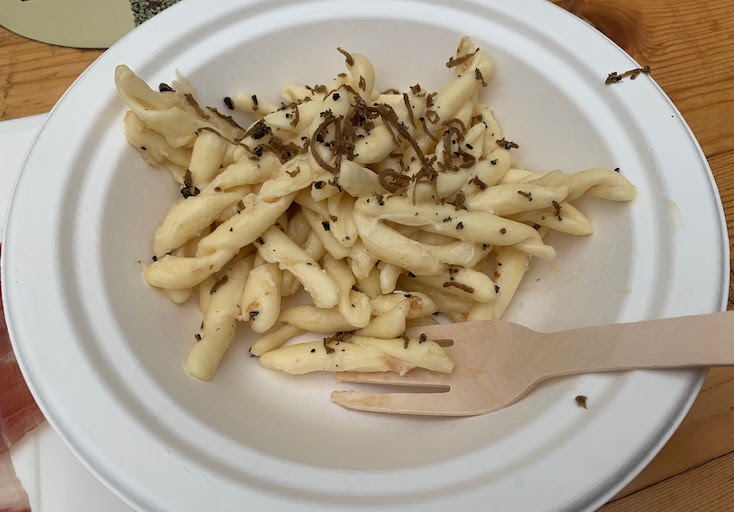
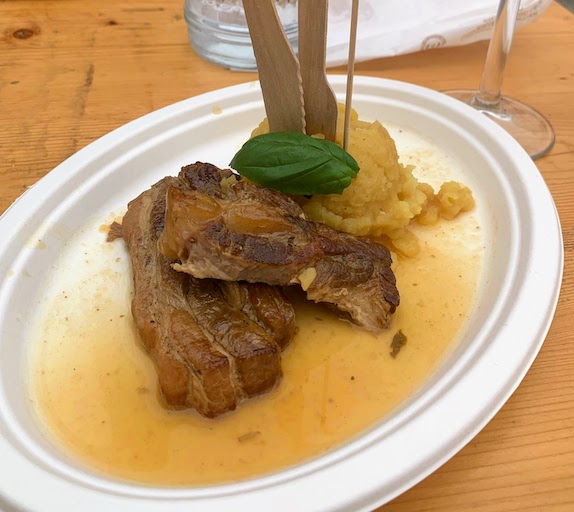
The main course was Slovenian comfort food from the Pri Mari restaurant on the Adriatic coast.
You can’t go wrong with ribs and potatoes.
Dessert was a cruffin – a hybrid of a croissant and a muffin – filled with pistachio cream. It came from Pekana Ana (Ana’s Bakery) in Ljubljana.
Chef Ana Roš owns the bakery. She also owns Hiša Franko, a three Michelin star restaurant in Kobarid, Slovenia
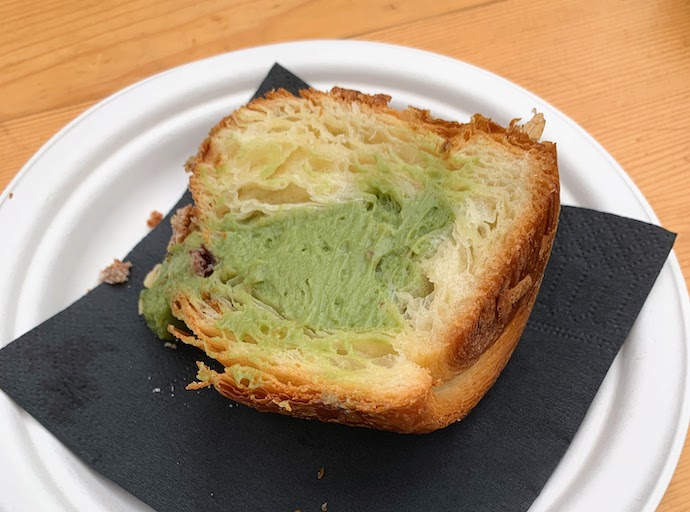
Goodbye, Ljubljana…at least for now
Our visit to Ljubljana, like the other stops on this trip, was too short. But it was long enough for us to become enchanted with the city. It’s a place we would like to return to for an extended stay.
On our last morning, we picked up some sandwiches at a local bakery and caught the Flixbus for Vienna. More on that on another day.
Until next time / Até a próxima vez
Mary and Mike
The Cook and The Writer
A quick scheduling note
In one of our most recent posts, we told you that we were planning to move back to the United States. Our move is now about two weeks away. We’re going to take a break from publishing so we can handle all the last minute details and then get settled in a new place. We’ll be back with a new post in early October.

What’s the best outdoor concert you’ve attended lately? Leave your review of the music in the comments below or via the Contact Us form.

We stayed in Slovenia for three weeks in May and found delicious chocolate. We had a favorite shop in Ljubljana and looked for more in every smaller town we visited. I love chocolate and consider Slovenia be of the top places for it.
Wow Mike and Mary – I’m ready to schedule a flight! But don’t worry, I won’t tell anyone else.
What a wonderful place to visit. I found Croatia wonderful, so I’m sure I would have loved Slovenia. In another life……Have safe travels back to the good ole USA
❤️
I was just there in June. Like you, I had not heard of it until recently. We spent a couple of days there as a side trip from Croatia. Beautiful place, wonderful people, and an intriguing mix of food influences.
Hope your move goes well!
What a great adventure! Thank you for opening up a window on yet another part of this amazing world!
Xo,
Nan
I’m hooked…,thanks
Wow, what a fun trip! But since I saw no chocolate, I will be sure to keep it a secret . . . Or did you just hide all the chocolate?
Ssshhhhhhh!
David